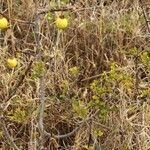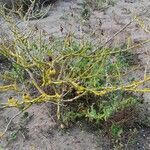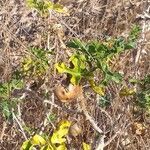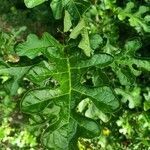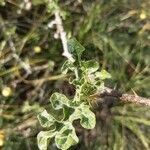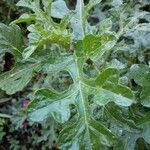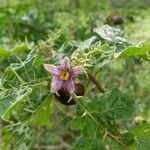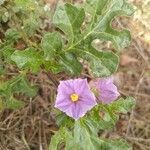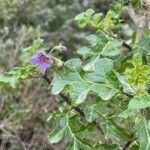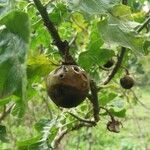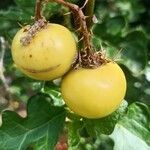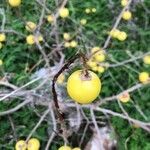Often rounded shrub to 1 m high, dark green, pubescent with stellate and some simple glandular hairs, the hairs sparse on upper leaf-surface, denser on lower surface; prickles to 15 mm long, common on most parts. Leaves elliptic, the lamina mostly 4–8 cm long, 3–6 cm wide, concolorous, deeply lobed; larger lobes sinuate; petiole 1–2 cm long. Inflorescence short, 3–6-flowered; peduncle absent or short; pedicels 10–15 mm long. Calyx 7–8 mm long; lobes lanceolate, 2–4 mm long. Corolla rotate-stellate to pentagonal, 15–20 mm diam., pale purple-blue. Anthers 4.5–6 mm long. Berry globular, 2–3 cm diam., yellow, finally brown or black. Seeds 2–3 mm long, light brown or mustard coloured. [See also Green (1994: 301).]
Shrub, up to 1.5 m high, young stems violet, vegetative parts, outside of calyx and corolla stellately pilose. Prickles subulate, ± broad-based, straight, ± yellow, up to 13 mm long. Leaves elliptic, up to 150 x 100 mm, sinuately lobed to pinnatifid with rounded lobes, ± glabrous, nerves prickly; petioles up to 30 mm long, prickly. Inflorescence 3-10-flowered. Calyx campanulate, up to 10 mm long, lobed ± halfway, prickly outside, enlarged in fruit. Corolla stellate, up to 25 mm in diam., mauve to purple, lobes broadly ovate. Flowering time Mar.-Dec. Fruit globose, glabrous, up to 30 mm in diam., green and white, ripening yellow. Seeds ± round, ± flat, up to 3 mm in diam., brown, finely pitted.
Leaves solitary, the upper ones often appearing geminate; petiole 1–4.5 cm long; lamina membranous, (2)4–17 × (1.6)3–12.5 cm, ovate or obovate, base subcordate or somewhat cuneate and ± unequal-sided, apex obtuse, deeply sinuate-pinnatifid or pinnatisect, the lobes broad to narrower and elongate, entire to deeply lobulate, often indented a quarter of the way to the midrib, rounded or obtuse, the sinuses rounded between the lobes, sparsely hairy, slightly more hairs beneath, ± prickly mainly on the midrib and secondary nerves.
Cymes lateral, usually leaf-remote, unbranched or rarely forked, racemiform, 2–8(10)-flowered, usually the lowest flower(s) larger and more prickly, occasionally all flowers unarmed, sometimes flowers solitary; peduncle 0–2 cm long, ± prickly; pedicels 0.5–1.4 cm long, slender to somewhat stout in fertile flowers, ± prickly or unarmed, erect or ± curved, in fruit elongated to 4 cm, strongly thickened chiefly distally, recurved or deflexed.
Calyx sparsely hairy, densely prickly on fertile flowers and sparingly so or ± unarmed on male flowers, in fruit somewhat enlarged, appressed to it, very prickly; tube 2–4 mm long, campanulate; lobes foliaceous, 2.5–7 mm long, elongating to 18 mm in fruit, triangular to linear-lanceolate, slightly scarious-margined, acute, hairy also inside.
Prostrate-ascending to erect perennial herb or shrub to 2.5 m (or more) high, armed; hairs stellate, sessile or stalked, with a short to long central ray, and also minute, simple, glandular hairs; prickles straw-coloured or yellowish becoming fuscous upwards, up to 15 mm long, stout, straight, subulate from a ± broad base.
Ovary 1.5–2.5 mm in diameter or 3 × 2 mm, globose or ovoid-ellipsoid, glabrous or with few sub-stellate, pauciradiate, and also minute, glandular hairs, near the top; style 6–9 mm long, very much shorter in male flowers, nearly straight, sparsely stellate hairy and also with a few minute, glandular hairs in the lower half.
Corolla violaceous, mauve or pale purple, with darker streaks towards the base of the lobes, 1.5–2.5 cm across, rotate-stelliform or orbicular-pentagonal; lobes broadly ovate, apically cuspidate, hairy outside and with a few hairs on midrib inside.
A shrub. It can grow 1.5 m tall. It is prickly. The leaves are deeply lobed and spiny and 15 cm long. There are 1 to a few flowers in the axils of leaves. They are mauve to purple. The fruit are yellow berries 25 mm across.
Fruit glossy, at first marbled green and variegated with white, later yellow and finally brownish to blackish, 2.5–4.5(5) cm in diameter, globose, glabrous, dry when mature, bitter and poisonous.
Shrub to 1 m; spines to 12 mm long, straight, yellow. Leaves deeply lobed, usually spiny, to 15 cm long. Flowers 1-few in axils, mauve to purple, 15 mm diam. Berries yellow, 25 mm diam.
Seeds light brown or mustard-coloured, 3–3.5 × 2–3 mm, flattened, lenticular, rounded or obovate in outline, conspicuously reticulate all over.
Stamen filaments 1–1.5 mm long; anthers 5–7 mm long, oblong in outline or ellipsoid-lanceolate, sub-cordate basally.
Branches sometimes purplish tinged, densely hairy at first, soon glabrescent, with scattered prickles.
Flowers 5-merous.
